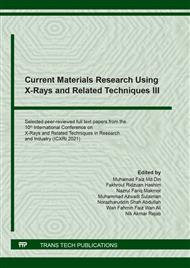p.367
p.373
p.379
p.385
p.392
p.400
p.406
p.414
p.419
Controlled Process of Radiation-Induced Grafting by Chemical Vapour Deposition for the Synthesis of Metal Adsorbent
Abstract:
Combination of high energy radiation and chemical vapour deposition in the grafting process for the synthesis of metal adsorbent was investigated. Radiation-induced grafting of glycidyl methacrylate onto kenaf fiber was performed in vapour phase to develop adsorbent for removal of aluminum from aqueous solution. Morphological changes of cross-section kenaf fiber was observed via scanning electron microscope and the thickness of co-monomer in the final graft co-polymer was determined. The comparison in cross-section morphology between ungrafted kenaf fibers and grafted kenaf fiber shows approximately 3.88 [μm] thick of additional grafted layer. The functionalization of the grafted fiber using imidazole was calculated grametrically and verified by elemental analysis. Imidazole has proven to be effective on the adsorption of aluminum ion. It was found that the adsorbent could remove more than 99% aluminum with the highest adsorption capacity of 4.93 [mg/g] at pH 4 and 60 minutes reaction time.
Info:
Periodical:
Pages:
392-399
Citation:
Online since:
January 2022
Keywords:
Price:
Сopyright:
© 2022 Trans Tech Publications Ltd. All Rights Reserved
Share:
Citation:


